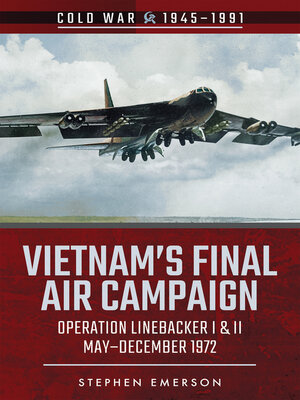Vietnam's Final Air Campaign
ebook ∣ Operation Linebacker I & II, May–December 1972 · Cold War, 1945–1991
By Stephen Emerson

Sign up to save your library
With an OverDrive account, you can save your favorite libraries for at-a-glance information about availability. Find out more about OverDrive accounts.
Find this title in Libby, the library reading app by OverDrive.



Search for a digital library with this title
Title found at these libraries:
| Library Name | Distance |
|---|---|
| Loading... |
An account of the last American bombardments that took place over North Vietnam while peace talks struggled in Paris. Includes maps and photos.
On March 30, 1972, some thirty thousand North Vietnamese troops, along with tanks and heavy artillery, surged across the demilitarized zone into South Vietnam in the opening round of Hanoi’s Easter Offensive. By early May, South Vietnamese forces were on the ropes and faltering. Without the support of U.S. combat troops—who were in their final stage of withdrawing from the country—the Saigon government was in danger of total collapse and with it any American hope of a negotiated settlement to the war.
In response, President Richard Nixon called for an aggressive, sustained bombardment of North Vietnam. Code-named Operation Linebacker I, the interdiction effort sought to stem the flow of men and materiel southward, as well as sever all outside supply lines in the first new bombing of the North Vietnamese heartland in nearly four years. To meet the American air armada, North Vietnamese MiG fighters took to the skies and surface-to-air missiles and anti-aircraft fire filled the air from May to October over Hanoi and Haiphong. With the failure of its Easter Offensive to achieve military victory, Hanoi reluctantly returned to the negotiating table in Paris. However, as the peace talks teetered on the edge of collapse in December 1972, Nixon played his trump card: Operation Linebacker II. The resulting twelve-day Christmas bombing campaign unleashed the full wrath of American air power. This book tells the story of these decisive campaigns and how they led, finally, to a ceasefire agreement.
On March 30, 1972, some thirty thousand North Vietnamese troops, along with tanks and heavy artillery, surged across the demilitarized zone into South Vietnam in the opening round of Hanoi’s Easter Offensive. By early May, South Vietnamese forces were on the ropes and faltering. Without the support of U.S. combat troops—who were in their final stage of withdrawing from the country—the Saigon government was in danger of total collapse and with it any American hope of a negotiated settlement to the war.
In response, President Richard Nixon called for an aggressive, sustained bombardment of North Vietnam. Code-named Operation Linebacker I, the interdiction effort sought to stem the flow of men and materiel southward, as well as sever all outside supply lines in the first new bombing of the North Vietnamese heartland in nearly four years. To meet the American air armada, North Vietnamese MiG fighters took to the skies and surface-to-air missiles and anti-aircraft fire filled the air from May to October over Hanoi and Haiphong. With the failure of its Easter Offensive to achieve military victory, Hanoi reluctantly returned to the negotiating table in Paris. However, as the peace talks teetered on the edge of collapse in December 1972, Nixon played his trump card: Operation Linebacker II. The resulting twelve-day Christmas bombing campaign unleashed the full wrath of American air power. This book tells the story of these decisive campaigns and how they led, finally, to a ceasefire agreement.







